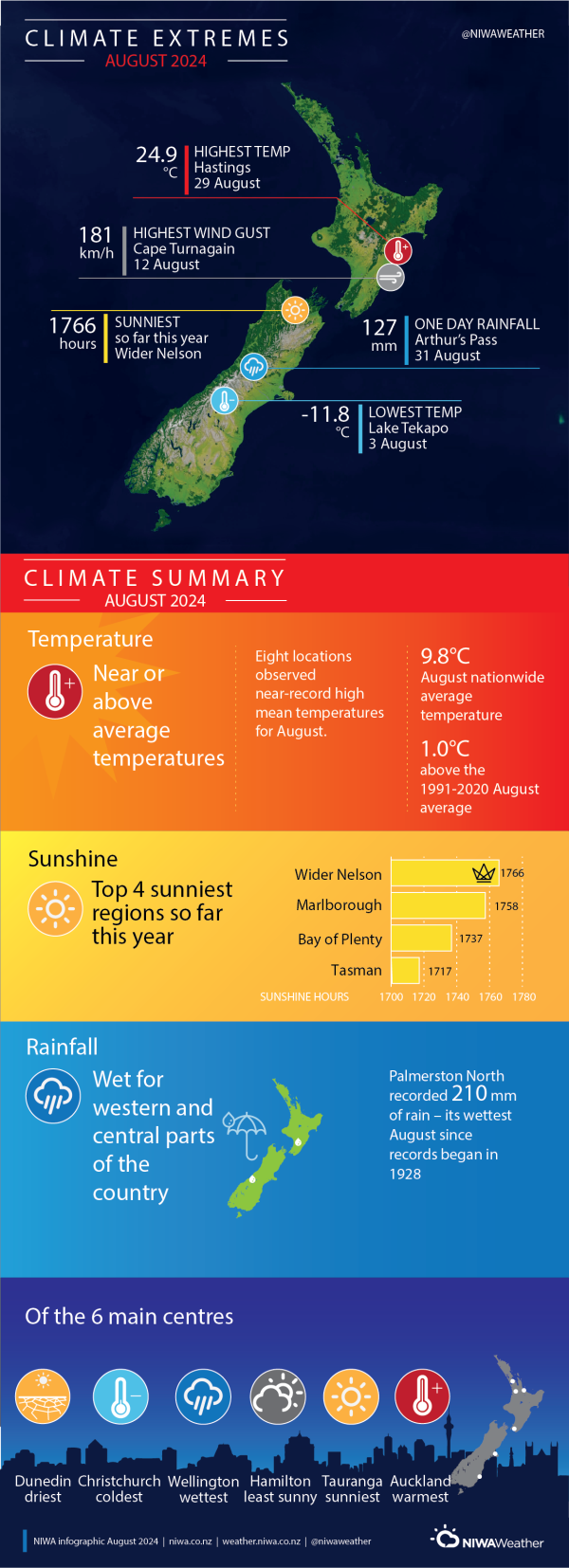| Temperature | Temperatures were near average (±0.50°C of average) or above average (0.51-1.20°C above average) for most of the country, with isolated pockets of well above average (>1.20°C above average) temperatures observed in parts of Northland, Hawke’s Bay, southern Taranaki, and Fiordland. |
| Rainfall | Rainfall was above normal rainfall (120-149% of normal) or well above normal (>149% of normal) for western, inland, and northern parts of the South Island, as well as lower parts of the North Island, and much of Taranaki. Rainfall was below normal (50-79% of normal) for eastern and southern parts of Northland, Auckland, Coromandel, Bay of Plenty, Gisborne, Hawke’s Bay, the Central Plateau, coastal Canterbury about and south of Banks Peninsula, and coastal North Otago. |
| Soil Moisture | At the end of the month, soil moisture levels were near normal for most of the country. Soil moisture levels were above normal for isolated parts of Central Otago. |
Overview
August 2024 mean sea level air pressure was higher than normal over Aotearoa New Zealand, and lower than normal to the south of the country. This was associated with more westerly winds than normal over the South Island, and more northwesterly winds than normal over the lower half of the North Island. This airflow pattern delivered occasional spells of above average temperatures for eastern parts of the country. Most notably, on 29 August Hastings reached New Zealand’s equal-fourth highest August temperature (24.9°C), while Whakatu reached 24.7°C (New Zealand’s equal-fifth highest August temperature). Whakatu also recorded 24.6°C on 18 August, which is New Zealand’s sixth-highest August temperature on record.
August temperatures were above average (0.51-1.20°C above average) for much of Northland, Auckland, Gisborne, Hawke’s Bay, Taranaki, Whanganui, Manawatū, Wairarapa, Wellington, West Coast, southern Marlborough, Banks Peninsula, mid Canterbury, eastern Otago, and Fiordland. Well above average (>1.20°C) temperatures were observed in isolated parts of Northland, Hawke’s Bay, southern Taranaki, and Fiordland. Remaining areas of the country experienced near average temperatures (±0.50°C of average). The nationwide average temperature in August 2024 was 9.8°C. This was 0.8°C above the 1991-2020 August average, making it New Zealand’s 9th-warmest August since NIWA’s seven station temperature series began in 1909.
The prevalence of westerly winds contributed to a relatively wet month for western and inland parts of the South Island, where rainfall was above normal (120-149% of normal) or well above normal (>149% of normal). Rainfall was also above or well above normal for Nelson, northern Marlborough, Wellington, Wairarapa, Kāpiti Coast, Manawatū, and much of Taranaki. In contrast, rainfall was below normal (50-79% of normal) for eastern and southern parts of Northland, Auckland, Coromandel, Bay of Plenty, Gisborne, Hawke’s Bay, the Central Plateau, coastal Canterbury about and south of Banks Peninsula, and coastal North Otago. It was especially dry for southern parts of Hawke’s Bay and Māhia Peninsula, where rainfall was well below normal (<50% of normal). Rainfall was generally near normal (80-119% of normal) for remaining parts of the country.
Further Highlights:
- The highest temperature was 24.9°C, observed at Hastings on 29 August.
- The lowest temperature was -11.8°C, observed at Lake Tekapo on 3 August.
- The highest 1-day rainfall was 127 mm, recorded at Arthur’s Pass on 31 August.
- The highest wind gust was 181 km/h, observed at Cape Turnagain on 12 August.
- Of the six main centres in August 2024, Christchurch was the coldest, Auckland was the warmest, Dunedin was the driest, Wellington was the wettest, Tauranga was the sunniest, and Hamilton was the least sunny.
- Of the available, regularly reporting sunshine observation sites, the sunniest four locations in 2024 so far are wider Nelson (1766 hours), Marlborough (1758 hours), Bay of Plenty (1737 hours) and Tasman (1717 hours).


